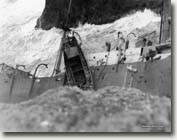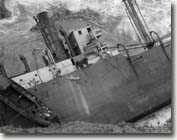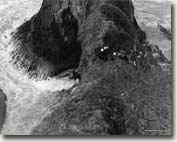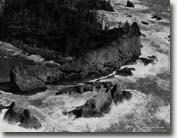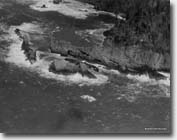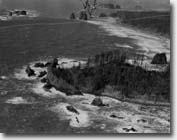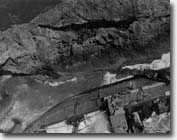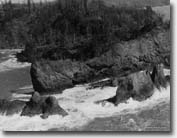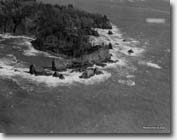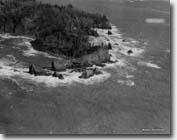 TEXT SIZE: small | normal | large | huge Lamut was originally launched into Lake Erie by the Great Lakes Engine Works in Ashtabula, Ohio as the as the Lake Elpueblo in 1919. She was a stee-hulled freighter of almost 2,700 tons and over 250 feet long. The Russian Merchant Marine aquired her (date unknown at this time) and renamed her Lamut. She transferred to the Pacifc, where she began operating runs between the US west coast and Soviet east coast. With the start of the war in the Pacific, Lamut's existance became more precarious. Japanese submarines were running in the area, and the Soviet Navy's submarine L-16 had even been torpedoed and sunk a few months previously off the Washington coast by the japanese submarine I-25. Fate, however, would drive Lamut to destruction with the ancient foes of mariners; storm and shore. With a load of cargo she had loaded in Portland, Oregon for delivery to to Vladivostok, Lamut was set upon by a storm that saw winds up to 75 knots. The storm raged off the coast on April 1st, 1943, and with the fall of night the heavy rains and surf from the waves frothed and misted enough that the normal navigational aids ashore were nearly invisible. Not surprisingly, her crew lost their bearings and grounded the ship on Teahwhit Head south of Cape Flattery in a treacherous area known as the Quillayute Needles. The pounding waves and jagged rocks soon rent her hull and she settled into the water between a sheer, 100-foot cliff and a small, ragged island. It was dark; just past 11PM, and the ship began to take on a dangerous list. A large oil drum broke free and struck the head of 19 year-old Koshova Alexandra, described later as "very pregnant," killing her and knocking her overboard into the pounding surf. A distress signal was sent out and was heard by the US Coast Guard, who deployed Coast guards men and boats to search for the beached ship. The Soviets aboard had tried to rescue themselves from the situation by launching a ship's boat in the dark, but the rain and darkness hid the cliff wall only yards away and the boat was lowered into rock and waves, causing the forward davit to give way. The bow of the boat dropped down, critically injuring another 19 year-old woman named Antonia Shmeliova in the fall. She and the others were pulled back aboard and the crew wisely decided to wait until day break, even though Lamut was leaning further over with each tortured groan. A Coast Guard surf boat pounded through the waves from the Beach Patrol Station at La Push while a ground team began to slog through the wet and saturated forest in the dark. The crew of the surf boat located the ship in the dark, but the waves and current were far too dangerous for them to attempt any sort of rescue and they stood by until dawn. By daybreak they had managed to trek through miles of jungle-like woods to a small beach two miles south of where the ship lay. The group of Coastguardsmen began the dangerous journey along wet and slippery rocks to the narrow ridge overlooking the ship. By the time the team arrived, Lamut was nearly over on her port side, forcing her crew to walk on the bulkheads instead of decks. One of the first things they saw were words painted in orange on her superstructure; "I wuman ill." But here, the Coastguardsmen were stuck with a dilemna, for they were a search party, not a rescue party. They had gone out lacking the ropes and tackle now necessary to affect a rescue. They were not short on resourcefulness, however, and began to form a light line from the medical gauze in their first aid kits. Eventually enough gauze was strung together that they were able to tie it around a rock and throw it across the chasm between to the trapped sailors. Laumt's sailors scrambled to the line's end and tied off a heavier line, which was then pulled back to the top of the cliff and secured. Chivalry was not dead, and the women were removed from the ship first. A small ledge had been cut into the cliff face by the elements, and the survivors were pulled one at a time over the roiling surf to shore. But this was not a safe haven, for they still needed to scale the cliff to the top before they could then begin the long trek through the wet woods to civilization. Antonia Shmeliova had been lashed to a stretcher, and the injured woman as well as the rest of the crew were safely guided across land and to safety. Legend had it that Soviet captains who lost their ships were put to death in punishment, and many of the Americans who had been involved or knew the area wrote letters to Premeir Stalin asking that Lamut's captain not be punished.
Virtual Tour: Links: Pacific Theater Home | Researcher@Large Home |
|||||||||||||||||
